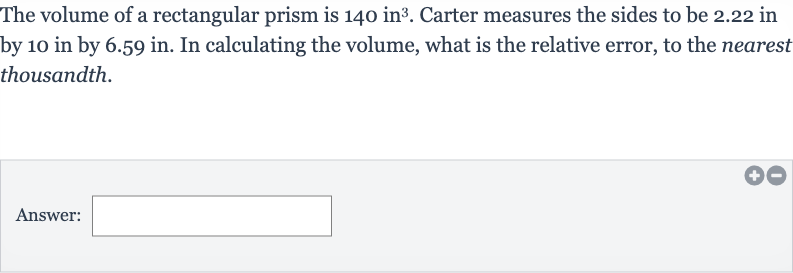Full solution
Q. The volume of a rectangular prism is . Carter measures the sides to be . in by in by . In calculating the volume, what is the relative error, to the nearest thousandth.Answer:
- Calculate Volume: Calculate the volume using the measured sides.The formula for the volume of a rectangular prism is .Using Carter's measurements, we calculate the volume as follows:.
- Perform Multiplication: Perform the multiplication to find the calculated volume.
- Compare Volumes: Compare the calculated volume with the given volume.The given volume is in.The calculated volume from Step is in.
- Calculate Absolute Error: Calculate the absolute error.Absolute error = .Absolute error = .Absolute error = in³.
- Calculate Relative Error: Calculate the relative error.Relative error = .Relative error = .
- Convert Relative Error: Perform the division and multiplication to find the relative error.Relative error = .Relative error .Relative error .
- Convert Relative Error: Perform the division and multiplication to find the relative error.Relative error = .Relative error .Relative error .Convert the relative error to the nearest thousandth.Relative error .To express this as a decimal to the nearest thousandth, we divide by and round to three decimal places.Relative error (rounded to three decimal places).
More problems from Pythagorean Theorem and its converse
QuestionGet tutor help
QuestionGet tutor help
QuestionGet tutor help
QuestionGet tutor help
QuestionGet tutor help
QuestionGet tutor help
Question
. Find the value of in degrees.Write your answer in simplified, rationalized form. Do not round.____
Get tutor helpQuestionGet tutor help

